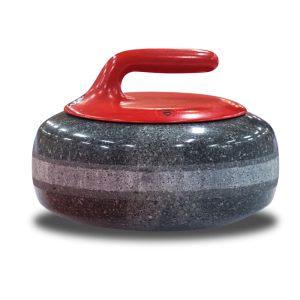By Derek D.V. Leung and Andrew M. McDonald
Harquail School of Earth Sciences, Laurentian University
ABSTRACT

- The collective features of all curling stone lithologies.
- The differences among the lithologies used for running bands versus striking bands.
- The presence of quartz, whose brittleness was previously considered to be undesirable in curling stones.
The four curling stone varieties from the two localities (Ailsa Craig Blue Hone, Ailsa Craig Common Green, Blue Trefor, and Red Trefor) were analyzed using petrography, scanning electron microscopy, digital image analysis, powder X-ray diffraction, and normative mineralogy, with the following results:
- The curling stone varieties that are suitable for international competition can be broadly characterized as fine- to medium-grained, sparsely porphyritic to glomeroporphyritic, weakly to moderately altered, massive to weakly foliated, Phanerozoic granitoids (sensu lato). All four varieties are composed of feldspar (65–80 mod.%, with albite being the dominant component) and quartz (15–25 mod.%), along with mafic and accessory minerals (5–20 mod.%). The Ailsa Craig suite is classified as alkali feldspar quartz syenite, whereas the Trefor suite ranges from quartz monzogabbro (Blue Trefor) to granodiorite-granite (Red Trefor). None are strictly classified as granite.
- Predominantly equigranular textures are preferred for running bands (Ailsa Craig Blue Hone), whereas seriate to glomeroporphyritic textures are preferred for striking bands (Ailsa Craig Common Green, Blue Trefor, and Red Trefor). These are consistent with observations of used curling stones: pitting adversely affects larger grains in the running band, whereas a wider grain-size distribution correlates with fewer crescent-shaped fractures in the striking band.
- The appreciable abundance of unstrained, interstitial quartz (15–25 mod.%) in all curling stone samples challenges the longstanding belief of its absence and undesirability in curling stones. The degree of strain in quartz is likely to be a key criterion for selecting prospective curling stone materials.
In conclusion, none of the examined characteristics of curling stones are unique in comparison to granitoids worldwide.
